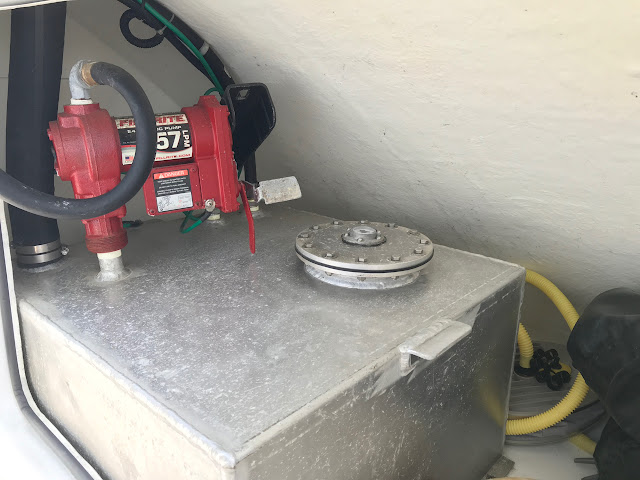Dinghy Time
Dock? Mooring Buoy? Anchor?
When traveling on a boat like Bravo, and you come to a harbor, you have three choices...
- Dock, can be expensive (even if space is available)
- Mooring Buoy, less money (most of the buoys are for smaller boats)
- Anchor, free (if there is a safe location)
At a marina, you usually have the convenience of hooking up to shore power; you step off your boat onto the dock, and walk to land. At anchor, or on a mooring buoy, you must use your dinghy to get to shore.
The Dinghy
Our dinghy is a Ribcraft 4.8T, with an internal fuel tank, and an arch which also has a divers boarding ladder. The dinghy is 15' 7" long, and is powered by a 60 hp Yamaha. It's a great dinghy that is stable, has room for guests, and is fast enough for us!
Dinghy Location
Bravo's dinghy is stored on the foredeck, and people often ask us, "How do we get the dinghy into the water?". So, we decided to do a blog explaining the process.
When the dinghy is on deck, it is strapped to the deck, and covered with a custom made snug fitting canvas cover. The davit (crane) is on the port side foredeck, and it is also covered with a canvas cover when not in use.
Fuel for the Dinghy
Our main engine, wing engine, and two generators, all run on diesel fuel. However the fuel for the dinghy is gasoline. Fortunately, Nordhavn built a 40 gallon gasoline tank inside the Portuguese bridge, complete with a gas station style pump. The hose is long enough to fuel the dinghy on deck, or when it is in the water next to the boat on the port side. We fill the 40 gallon fuel tank, as needed, when we pull up to a fuel dock. The capacity to carry extra gasoline enables us to be more independent, and not carry those pain in the neck red plastic gas cans!
The Davit
The davit on Bravo is a hydraulic Steelhead Marine ES1500 model, which has a lifting capacity of 1500 pounds, with a 12' reach. It has a hand held remote control to operate the davit.
Launching the Dinghy
The following pictures show our step-by-step dinghy launch choreography.
Mission Accomplished!
We have to admit the first time we launched the dinghy it was a bit nerve racking for sure. But it got easier and easier with each launch.
To bring the dinghy back on board Bravo, the previous steps are executed in reverse order. Easy-Peasy!
Recent Upgrade
We added a chart plotter to the dinghy, which will help in any night time ventures. It also functions as a navigation tool to identify courses to best avoid shallow areas.
Thanks and keep those questions and comments coming!
*** Pictures of the dinghy launching taken by Pam Hunnicutt.
When traveling on a boat like Bravo, and you come to a harbor, you have three choices...
- Dock, can be expensive (even if space is available)
- Mooring Buoy, less money (most of the buoys are for smaller boats)
- Anchor, free (if there is a safe location)
At a marina, you usually have the convenience of hooking up to shore power; you step off your boat onto the dock, and walk to land. At anchor, or on a mooring buoy, you must use your dinghy to get to shore.
 |
| Bravo at anchor. |
The Dinghy
Our dinghy is a Ribcraft 4.8T, with an internal fuel tank, and an arch which also has a divers boarding ladder. The dinghy is 15' 7" long, and is powered by a 60 hp Yamaha. It's a great dinghy that is stable, has room for guests, and is fast enough for us!
 |
| Our dinghy. |
Dinghy Location
Bravo's dinghy is stored on the foredeck, and people often ask us, "How do we get the dinghy into the water?". So, we decided to do a blog explaining the process.
When the dinghy is on deck, it is strapped to the deck, and covered with a custom made snug fitting canvas cover. The davit (crane) is on the port side foredeck, and it is also covered with a canvas cover when not in use.
 |
| Dinghy on front deck covered with canvas cover. |
 |
| Dinghy sits on stainless cradle, and is held down by four tie downs. |
 |
| Top view of dinghy and davit. |
 |
| View of Bravo with dinghy off loaded. |
Fuel for the Dinghy
Our main engine, wing engine, and two generators, all run on diesel fuel. However the fuel for the dinghy is gasoline. Fortunately, Nordhavn built a 40 gallon gasoline tank inside the Portuguese bridge, complete with a gas station style pump. The hose is long enough to fuel the dinghy on deck, or when it is in the water next to the boat on the port side. We fill the 40 gallon fuel tank, as needed, when we pull up to a fuel dock. The capacity to carry extra gasoline enables us to be more independent, and not carry those pain in the neck red plastic gas cans!
 |
| 40 gallon gasoline fuel tank built into the Portuguese bridge.. |
 |
| Fill her up! Just like going to the gas station. |
The Davit
The davit on Bravo is a hydraulic Steelhead Marine ES1500 model, which has a lifting capacity of 1500 pounds, with a 12' reach. It has a hand held remote control to operate the davit.
 |
| Remote controller for the davit. |
 |
| Controller plugged into the davit and ready to go. |
Launching the Dinghy
The following pictures show our step-by-step dinghy launch choreography.
 |
| Canvas covers removed from dinghy and davit. |
 |
| Side railing is opened, tie downs are removed, controller made ready. |
 |
| Davit is extended, and davit lifting hook is connected to dinghy lifting harness. |
 |
| Lines are in place, and davit adds tension to the lifting harness. |
 |
| Up, up, and away! We have lift-off! |
 |
| Just starting to rotate the dinghy. |
 |
| Slowly being raised up to clear the railing. |
 |
| This is now raised high enough to clear the railing. |
 |
| Starting to rotate the dinghy to the side of Bravo. |
 |
| Dinghy is now lined up on the side of Bravo. |
 |
| Slowly being lowered. |
 |
| Dinghy is now 8' above the water, and ready to be boarded. |
 |
| Nora now boards the dinghy, and lowers the tilt of the outboard motor. |
 |
| Nora and dinghy are now at water level. Nora starts the outboard motor up. |
 |
| After disconnecting the lifting hook from the dinghy, Nora brings the dinghy to the back of Bravo. |
Mission Accomplished!
We have to admit the first time we launched the dinghy it was a bit nerve racking for sure. But it got easier and easier with each launch.
To bring the dinghy back on board Bravo, the previous steps are executed in reverse order. Easy-Peasy!
Recent Upgrade
We added a chart plotter to the dinghy, which will help in any night time ventures. It also functions as a navigation tool to identify courses to best avoid shallow areas.
Thanks and keep those questions and comments coming!
*** Pictures of the dinghy launching taken by Pam Hunnicutt.




Comments
Post a Comment